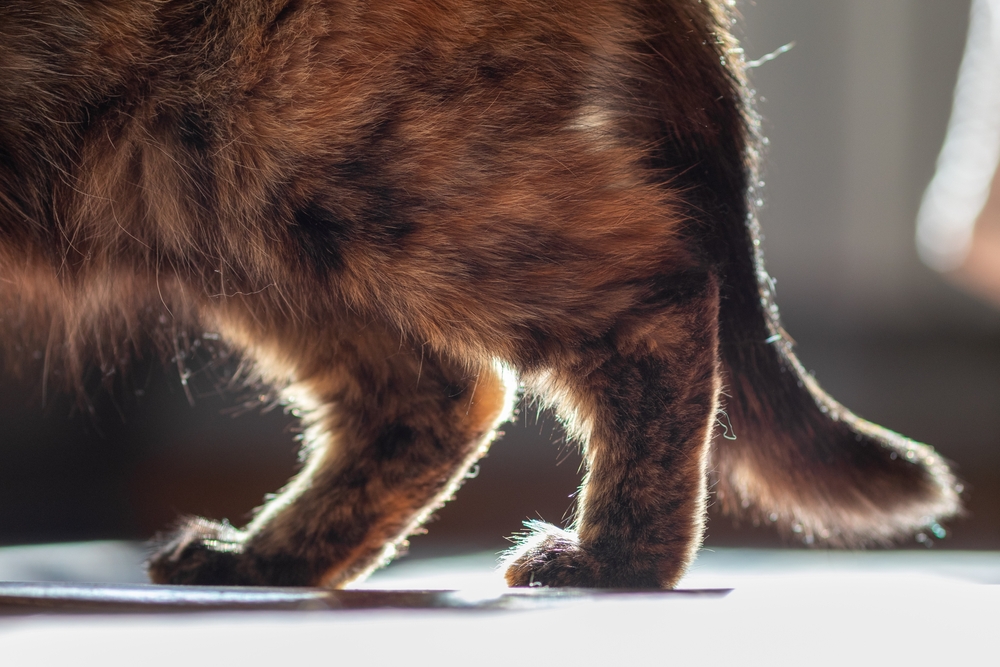Cats are mysterious creatures who are incredibly adept at hiding all sorts of things, especially illnesses and injuries. As both a prey and a predator species, cats are hardwired to conceal their weaknesses, so you may not realize your feline friend is under the weather until a problem has progressed.
In particular, this survival tactic makes diagnosing feline arthritis difficult. Because cats’ arthritis signs are different from signs dogs commonly exhibit (i.e., limping), and joint changes do not always appear on X-rays, feline arthritis may go undiagnosed. In addition, because they are often extremely anxious when in the veterinary exam room and unwilling to cooperate during an orthopedic examination, cats are typically difficult to examine for arthritis.
Recent studies have shown that feline arthritis is much more common than previously believed, with 60% of cats exhibiting arthritis signs by age 6, and 90% of cats older than 12 having evidence of degenerative joint disease. To ensure your whiskered pal gets the pain relief they need to move comfortably our Companion Care Animal Clinic team must be able to diagnose their arthritis before the condition causes severe joint damage. To help determine if your feline friend has arthritis, keep an eye out for the following common signs.
#1: Your cat is not using the litter box appropriately
Consider how your feline friend typically uses a standard-sized litter box. Cats have to lift their legs high, or even jump to get into and out of the box. Once inside the litter box, your cat has to get into an elimination posture, hunching their back and crouching on their legs. If your whiskered pal has arthritic elbows, knees, hips, or spine, eliminating in the litter box can be difficult and uncomfortable.
Because of these mobility impairments, your cat may urinate and defecate next to the litter box. If your feline friend is in considerable pain when they posture to eliminate once in the litter box, they may avoid the box altogether and seek soft fabrics and surfaces in an attempt to reduce their discomfort. So, your cat may relieve themself on the bathroom rug, the laundry pile on the bedroom floor, or the blanket pooled on the floor next to the couch.
#2: Your cat’s coat is unkempt
A cat with no arthritis-induced joint damage is limber and flexible, able to contort easily into pretzel-like positions to groom every square inch of their body. If your furry pal’s joints lack adequate cartilage cushioning that causes bone to grind on bone, they certainly don’t feel like bending and stretching. An arthritic cat often fails to groom their hind end because that body area is difficult to reach when their stiff spine and limbs no longer flex like they should. Alternatively, an arthritic cat may overgroom a painful area, licking the affected joint bald in an attempt to soothe the pain.
#3: Your cat no longer jumps or climbs up to their favorite spot
Stiff, sore joints are no longer spring-loaded for leaping onto furniture or scampering up lookout towers. If your whiskered pal has arthritis pain, they may avoid their favorite lounging area on the back of the couch, or they may no longer climb to their multilevel playground’s summit. If your feline friend is staying at floor level and meowing beseechingly up at you for a lift, they may be experiencing arthritis pain.
#4: Your cat is moodier than usual
Cats are often accused of having moody personalities, but if your furry pal transforms from a purring lap potato to a hissing spitfire, that’s a sure sign something is wrong. Arthritic cats often voice their complaint when stroked over painful joints such as their hips. Your feline friend may tense, hiss, or swat at you when you pet a particular spot, or they may take off running to hide.
In addition, a cat experiencing arthritis pain may avoid all interaction. Your arthritic whiskered pal may no longer want to join in the family’s movie night and cuddle on the couch, because jumping up and being petted are two activities that cause discomfort. In addition, your arthritic cat may avoid play with their younger household kitty companion and throw a pawful of claws the other cat’s way when they approach.
#5: Your cat’s appetite has decreased

When a cat is in pain, they typically lose their appetite. As joint cartilage erodes and bone spurs form in arthritic joints, your cat’s discomfort increases, taking a toll on their hunger. Your feline friend may opt to hang out in bed rather than head to the food bowl because of the soreness they experience while walking and bending down to reach their dish.
Arthritis is an extremely common pet condition, particularly in seniors. Although your cat may not complain about painful joints, the chance that they have arthritis is high, especially if they are in their golden years. If you suspect your feline friend is suffering from joint degeneration and pain, schedule an appointment with our Companion Care Animal Clinic team.







Leave A Comment